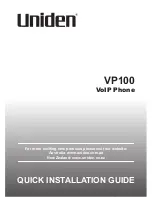
AMT/PTD/TR/0001/3/7/EN
Installation Manual for digital sets - IP sets - SIP sets
Page
5-8 05/2008
To install sets and cartridges in the i7XX range
•
DCF 459 for the random time range before a new attempt to open a TCP/IP session. This
parameter is encoded over 16 bits, i.e. one byte for the minimum value, and one byte for the
maximum value.
•
DCF 429 for the time between two audits (10ms unit). The audit is automatically deactivated if
the value of this parameter is 0.
5.1.5
Quality of service
i7xx sets use the IEEE 802.1 q/p frame standard, defined to manage QoS (quality of service) in IP
telephony.
End-to-end quality of service (QoS) must exist on the local area network (LAN). It is based on the
prioritisation of Succession or M6500-IP network “voice” and “signal“ frames in LAN equipment
(switches and routers).
The IEEE 802.1q standard consists in adding a field to the initial Ethernet frame header (IEEE
802.3), to manage virtual networks (VLAN) and the priority for "Priority bit" flow (according to IEEE
802.1p).
Characteristics of Ethernet 802.1Q frames
QoS has 3 aspects:
•
reliability (preventing data loss),
•
prioritisation (prioritising network accesses),
•
security (identifying network accesses).
The IP messages and dialogues are conveyed through Ethernet frames that consist of a tagged
QoS 802.1 Q field and the data (voice exchange).
The 802.1Q standard includes 2 functions: management of virtual networks (VLANs) and
management of flow priority (802.1p).
The switch built into the i7xx set is programmed to prioritise "telephony" frames over "data" frames
from a PC that is connected to the set.
The PC belongs to the VLAN that is allocated to the network's switch port to which the built-in
switch is connected. It receives the network's untagged frames.
















































